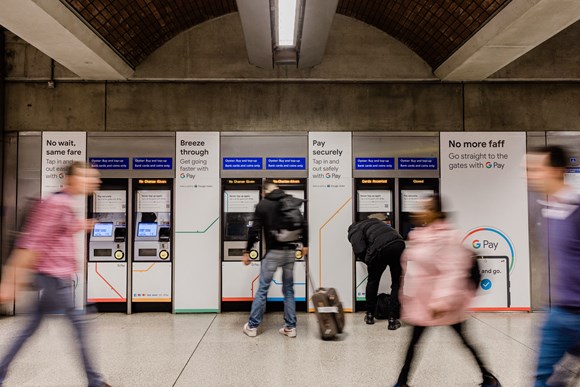More people are using contactless via a mobile phone or smart watch to travel on the London Underground than they were prior to the pandemic, new analysis by Transport for London (TfL) has revealed.
The new figures show that in a four-week period from the end of July to late August 2022, around 485,000 journeys a day were being made on the Tube using a mobile device. This equates to around 35 per cent of all Tube adult pay as you go journeys made using contactless or around 25 per cent of all adult pay as you go journeys. Prior to the pandemic (around the end of January 2020), there were around 400,000 contactless journeys a day being made using a mobile phone or smart watch – which was just 26 per cent of all pay as you go with contactless journeys and around 16 per cent of all Adult pay as you go Tube journeys.
Using pay as you go with contactless means that customers can simple touch in and out at stations, meaning they can avoid queueing at ticket machines or the need to top-up their Oyster card. The system then automatically calculates the best value fare based on the customer’s specific daily journey history and charges them at the end of the day – ensuring they always pay the lowest fare in the easiest and most convenient way.
The popularity of pay as you go with contactless has grown in recent years, particularly with customers using mobile devices as more people adopt the latest smartphone technology. Across London, contactless journeys now make up around 71 per cent of all pay as you go journeys on buses, Tube and rail services in and around London, up from around 31 per cent in 2016.
The contactless system covers all Tube, bus and tram services, as well as rail services as far as Gatwick Airport in the south, Luton Airport, Welwyn Garden City in the north and Reading, Marlow and Henley-on-Thames in the west. It can also be used on the Uber Boats with Thames Clippers and the IFS Cloud Cable Car.
By automatically working out the correct fare for customers and only then charging the total at the end of the day, customers can also save money compared to buying a Day Travelcard, helping them to travel around London more affordably. Despite the growth in contactless on the Tube, thousands of paper tickets are still being sold every day in Tube stations – for example, at King’s Cross station, around 1,000 paper ‘Day Travelcards’ are sold every day. Thanks to daily capping, it would be cheaper if pay as you go with contactless was used instead, as all caps are set at a lower rate than the cost of a one Day Travelcard.
To encourage customers to avoid queueing and move from paper tickets to more convenient, smarter ticketing, Google Pay has recently begun a six month creative campaign across five of London’s most high profile Tube stations. Within these stations, customers will see signage prompting them to add a debit or credit card to Google Wallet. Once a card is added to the app, customers can skip the queue for ticket machines and simply pay contactless with Google Pay. Signage on ticket readers at Tube stations across the network has also been refreshed to better emphasise contactless options alongside the traditional Oyster card.

Google has also made improvements to its suite of apps to help provide better access to public transport information within London and let customers know that they could use Google Pay to travel on London’s public transport network, rather than queuing to buy a paper ticket.
Andrew Anderson, Head of Customer Payments at TfL, said: “We are committed to making travel in London as easy as possible. Millions of journeys in and around London are now made using contactless every day – with close to half a million now made using mobile devices rather than a bank card. Working with Google Pay, we are helping promote the benefits of smart ticketing over queuing to purchase traditional paper tickets, making travel more convenient and accessible for all.”
For more information about pay as you go with contactless, please visit www.tfl.gov.uk/contactless


